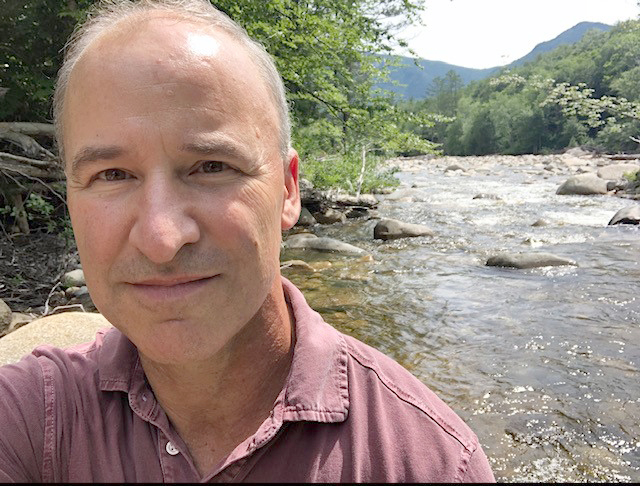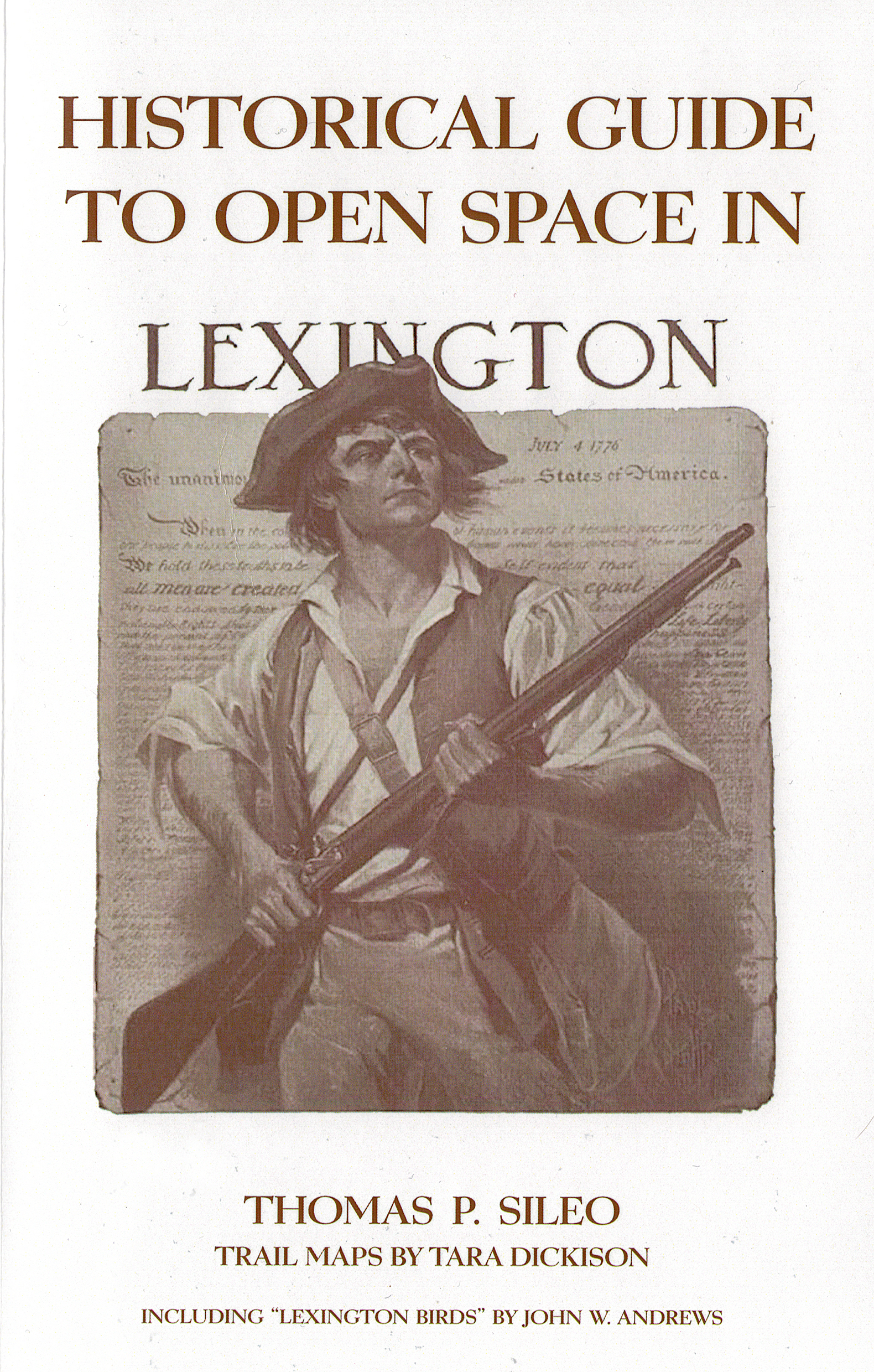Exploring Lexington’s ‘Outdoor Museums’ with Tom Sileo

During the coronavirus lockdown, many of us turned to the outdoors to escape cabin fever and help us deal with the anxiety and despair happening around us. Nature has a well-researched restorative effect. Humans are wired to have an affinity for the natural world, according to E.O. Wilson, professor emeritus of biology at Harvard. In his 1984 book Biophilia (which loosely translates to “love of life”), Wilson says that our love of nature is an evolutionary desire to be surrounded by other forms of life in the natural world. It is therapeutic, especially in a time of uncertainty.
It’s no wonder that Lexingtonians Les and Cindy Savage turned to walks as a respite from being cooped up. In 1995 Lester purchased many copies of a book written by Lexington resident Tom Sileo. He would give the book to his real estate clients as a gift. The book, Historical Guide to Open Space in Lexington, is a multi-faceted guidebook to each of the conservation properties in Lexington. But it is so much more than your standard handbook for nature lovers. It is a book designed to immerse the reader in the history of each place—the ways that the land was used by its owners and the human-made contributions to the landscape. Additionally, it contains Tom’s knowledgeable observations on plants and tree species as well as animals and birds you might find there.

Setting out for a walk on conservation land, Les and Cindy would grab the book and head out with a couple of friends to explore. “We started to read about the interesting history of these places…and very quickly we realized the value of this rich history, and the book,” Cindy says. They started giving Les’s last copies away to their friends. Soon the word got out that they had this book, and the requests started coming in. With their supply dwindling, the couple reached out to the author and convinced him to reprint this invaluable resource.
The book has now been updated and reprinted and is for sale at the Buckman Tavern gift shop in Lexington. Tom has generously decided to donate the proceeds from the book’s sales to the Lexington Historical Society and the Lexington Conservation Commission.
I now have my copy of the book, and I understand what a great resource it is! Each chapter is devoted to a different property and contains the relevant history of the place, observations about flora and fauna, and suggested walks. It makes a lively and entertaining walking companion and a great way to learn about the history of the community through the years.
At Cindy’s suggestion, I contacted Tom, and we talked about the book and how he came to write it, his love of history, and the natural world.
This conversation has been edited for length and clarity.
Laurie Atwater: Would tell me a little bit about this book and how you got the idea to write it back in 1995?
Tom Sileo: Well, Alice Hinkle, at the time, was the editor of the [Lexington] Minuteman. She loved the conservation lands, and I loved the outdoors. I was living in Lexington then. My grandfather lived in Lexington for a long time, and I moved from Boston to Lexington because I was familiar with it. Previous to that, I did a little bit of writing on the outdoors. So when I came to Lexington, I started walking the conservation lands, liked what I saw, and I liked the whole philosophy. So I started writing articles that Alice Hinkle published in the Lexington Minuteman.
What’s an example of a typical article you might have written for the Minuteman?
For instance, I might do Whipple Hill. I’ll go over the history of Whipple Hill, as I could find it from the library, the town hall, the Town Clerk’s office. Then I would combine that history with the previous land uses that make up the property that caused it to be the way it is. And then, I would describe a suggested walk and a natural history of a place. I’m familiar with, plants, flowers, and herbs. So it would be a fairly light article that would describe a bit about the history a bit about the physical nature of the place.
So, I started doing research on Lexington’s history and on these properties. And I realized that so much happened in Lexington that people aren’t familiar with because it’s overshadowed by, of course, revolutionary history.
So I decided that I could use these properties as “outdoor museums.” It fit with the conservation commission’s philosophy—to try to have a conservation land in everybody’s backyard. I discovered that in the early days, they really fought hard to preserve these properties. And David Williams is unbelievable—he’s the guy behind the curtain who is so vocal about conservation land and protecting property. He makes it all happen. So, for instance, when you drive down 128 in Lexington, you don’t see lots of buildings. You get a sense that Lexington is this rural town because as you pass through it on the highway, you see these conservation lands. So, they did a very thoughtful job of this.
I was a stockbroker back then, and I ended up taking time off to write. For this project, I spent hours in the registry of deeds in Cambridge. What I wanted to do is take each of these, as I called them, ‘outdoor museums,’ and find the very first settler of these properties. Then I discovered the original grant for the properties and traced that through to the time when the Conservation Commission protected that land forever.
Originally they were big, big, lots of land. They were eventually broken up, and different owners had different uses. I went to the Town Clerk’s office, and I found who had how many cows, how many oxen, and even a listing of slaves (which there really weren’t many slaves in Lexington). The Town Clerk’s office has all that. I’d trace back every exchange of property, and get to know what the property looked like. I’d look at old photos, I talked to hundreds of people who were around or remembered people who were around going back to the 1920s, ’30s. [Larry] Whipple, one of the guys who was a part of the Historical Society, had done these wonderful interviews, and they were all on tape. I listened to every one of them!
I started to piece together everything that happened on these properties with the idea that it was these land uses that created their character. And so for instance, you go to Paint Mine—that was a place where they manufactured the paint that painted some of the houses in Lexington. It was an old ochre mine. There were old muskrat dens there. That’s a defining feature of that property. The Great Meadows was a peat bog. Peat was a big deal when wood ran out. And that defines why that place looks as it does. Similar to Dunback Meadow, which also had peat bogs.
Then there’s Whipple Hill and the old Fairlawn Nursing Home. Originally the guy who owned the Parker house in Boston, he put his mistress up there when his wife was sick, and she owned that place. These fascinating stories are all documented in the book.
Most people aren’t aware that Lexington was once a summer resort destination for Bostonians anxious to escape the city heat. Quite a few of the estates were built as summer homes.
Yes, I wrote a book also about Horn Pond in Woburn, and that was another destination for Boston people who wanted to go out to the country. There was also a trolley that went out to Benson’s Animal Park [on Bedford Street in Lexington], and that [park] was a destination for recreation. Eventually, Bensons moved up to Hudson, New Hampshire, and it became an even bigger thing.
So, there’s all these pieces that I think make Lexington so interesting as a town—above and beyond the Revolution. There was even a mysterious death when they were digging the Old Res! That’s in the book. Race tracks were big. I have a photo of a sulky track on Middleby Road. That was very popular. Some crazy stuff happened in town, so I wanted to take all this information and put it all together into one book. You can take the book and walk the properties and stand there and go, ‘Wow, this is what happened in this place.’
Each wave of immigration also brought something new to Lexington.
Yes, this was interesting; I do talk about this in the book. There was a family that wanted to move to Lexington when the Protestants ran Lexington. They refused to sell to the Catholics, so the Catholics would hire what they called ‘the straw buyer’—someone who would step in and buy a property—someone acceptable to the Protestants, and that’s how they came in. So you had all these Irish coming into East Lexington the 1860s.
And then, in the 1900s, the Italians like the Busas came in and started farming. There were also numerous pig farmers, and the pig farmers were the garbage men! When the piggeries came in, the old line Lexington gentleman farmers hated it because it started to stink. And the furriers too, that was another industry that was not looked too well on. The well-known Robbins family of East Lexington were furriers.
When I started putting all this together, I suddenly I had a 370-page book! My, now, ex-wife [Tara Dickison], did all the maps. We did it all by hand, just going around each property. I would do hundreds of walks. I was so afraid that the Lexington Historical Society wouldn’t like this book coming out because they had this pristine view of Lexington as this noble town that played a big part in the Revolution. But they were very generous, and they provided a lot of information. I did go to Concord in order to try to place the book to sell there, and this older woman looked at me, and she said, “You take your Lexington book back to Lexington.” In ’95, I sold thousands of these books, and I did hundreds of talks. People in Lexington just loved their local history.
One of the other things that I added to the book, and I kept in the revision, was a marvelous listing of the birds in Lexington written by John Andrews a long-time Lexington resident and birder. I put that into the book, and I added a few things to it. It’s a nice piece for anybody interested in birding.
I had the book printed appropriately by the Minuteman Press, and they did a nice job. I added some new information and photos.
Are you still writing books or columns?
I just finished an extensive 600-page book on Wildlife Pond, which is up at Beaver Brook in Hollis, New Hampshire. And it’s basically the whole history— birds, plants, and everything that happens throughout the year. I do nature photography too, so that book has a lot of my nature photography. And, then I’ve written a novel. I am one of those guys who has to write. Maybe one day, when I retire, I’ll start to publish and sell those things seriously, but for now, it’s just a fun diversion.
